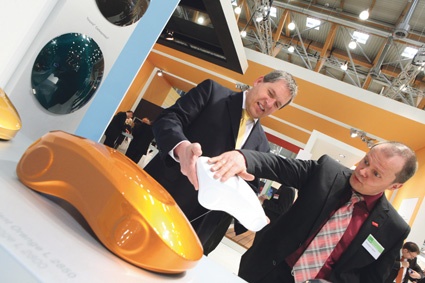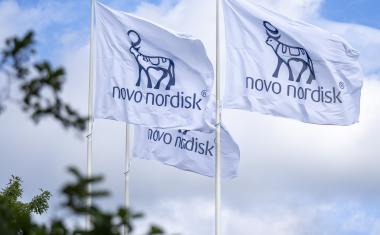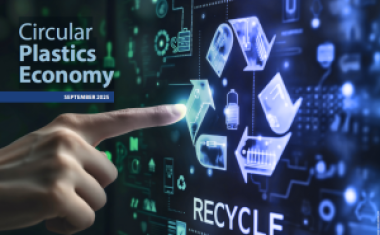Combining Performance and Sustainability



Formulating The Future - Decreasing availability of classic raw materials such as oil affects the coatings industry like any other. The European Coatings Congress in Nuremberg therefore will focus on biobased and sustainable coatings. Presenting the latest results and industrial developments, the congress will cover the full range of processes and raw materials for the formulation of coatings, inks, adhesives, sealants and construction chemicals. From March 17 to 19 more than 144 selected papers will provide the industry's latest trends and innovations.
Tutorials
In 11 pre-congress tutorials, numerous experts will offer training opportunities from the fields of functional and architectural coatings to renewable chemicals and more. Dr. Jamil Baghdachi from Eastern Michigan University will discuss efforts to reach the goal of sustainable technologies without compromises. Dr. Adrian Beard and Daniela Eisenhauer from Clariant will cover flame-retardant fundamentals as they speak about the burning behavior of different materials as well as flame-retardant and fire-resistant coatings. The pre-congress tutorials will be on March 17, right before the congress officially starts. Seats for these tutorials are limited, and since the main congress and the tutorials are individual events, pre-registration is recommended.
Congress Highlights
Keynote speakers for the main event on March 18-19 are Dr. Adithy Ranade from Lux Research and Klemens Bartmann from DuPont Performance Coating. The combination of performance and sustainability will play a crucial role in both speeches. Ranade will cover assessing sustainability in architectural coatings. He will reveal a tool to assess the true sustainability value of coating technologies relative to their performance value to the end user. Klemens Bartmann, on the other hand, focuses on new sustainability challenges for global players in the coatings industry. He will discuss how to approach environmental regulations and how to turn challenges into opportunities.
The 24 main sessions will start with trends in automotive coatings. How novel polyester diols and urethane polyols are capable of imparting and enhancing a variety of properties in high-performance coatings is one of the most discussed issues. John Florio and Dr. Ravi Ravichandran from King Industries will dedicate two sessions to the advantages of these diols and polyols in high-performance amino-formaldehyde cross-linked coating applications.
The pressure on reduction of critical solvents in coatings and resins is another challenge within the automotive industry. Robert Harrer from Cytec will present a new solvent-free waterborne two-pack binder for plastic coatings, which can be used for applications with highest demands, such as automotive interiors. Dennis Heymans from Momentive Specialty Chemicals will take his listeners on "a possible route to solvent-free transportation and automotive topcoats." He will demonstrate how to optimize the process of solvent distillation from high-quality acrylic resins.
The session "Science Today - Coatings Tomorrow" will cover a wide field of highly innovative topics. Professor Bernhard Rieger, WACKER-Chair of Macromolecular Chemistry, TU Munich, will discuss "Materials for the 21st Century" and the question "Can carbon come from CO2?"
How to use responsive nanoparticles to form coatings that change their surface properties is the issue of Professor Andres Fery from the University of Bayreuth. He will point out the perspectives of this approach for the example of bioactive coatings. So-called nanogels or microgels are the topic of Professor Walter Richtering. He will present the advantages of functional microgels as smart ingredients for waterborne coatings.
Waterborne Coatings
Challenges of waterborne coatings keep the industry busy, and innovations to face those challenges will be presented at the European Coatings Congress. Benoît Magny from Arkema will lead the "waterborne coatings" session. New defoamer lines and foam control agents have been developed to ensure predictable performance of waterborne coatings. Dr. Sowmitri Tarimala from Ashland and Christine Louis from Air Products will talk about these new developments and their value for the industry. Dow Chemical will send Dr. Jay Romick to Nuremberg to present new waterborne polyolefin dispersions. These dispersions can facilitate coatings with excellent chemical resistance, adhesion to metal and flexibility.
Antimicrobial Properties
How to use the power of silver for antimicrobial purposes will be discussed on March 19. Alexandra Pica from the Research Institute for advanced coatings will talk about the influence of silver nanoparticles on the morphology of film-forming materials and their antimicrobial efficiency.
Achieving antimicrobial characteristics of coatings without using silver is the aim of Dr. Alan Taylor. He will introduce CuViTo, a European-Mexican joint venture aimed at developing new products for the Mexican mining industry. To avoid high raw material costs, CuViTo is doing research with copper instead of silver. The challenge for copper coatings is to restrain the copper nanoparticles in a structure that provides antibacterial functionality. The financial opportunities might be worth this effort.
Nanotechnology
Nanotechnology can be used not only to achieve antibacterial characteristics but also for a wide range of applications. Because of availability of new materials there are still only a limited number of products containing nanoparticles on the market. Ninja Hanitzsch from Byk-Chemie will be "Breaking New Ground" as she presents additives based on nanoparticles, which are easy to handle and ready to use. Research and investment in nanotechnology already has led to interesting results: Additives based on carbon nanotubes can be used as a versatile material to achieve new functionalities in coatings. Tobias Tinthoff, also from Byk-Chemie, will explain how to take advantage of this new and fascinating material.
Sustainability and Biobased Coatings
Nevertheless, sustainability and the role of biobased coatings are the most important issues of this year's congress. In a session led by Dr. David Löf from PPG Europe, the latest innovations in biobased coatings will be presented. In order to improve the carbon footprint, renewable materials like sugar play a more crucial role. How sugar-derived biobased building blocks can be used to build polyester resins will be explained by Bas van Leeuwen from Purac.
To find sustainable solutions in high-performance coatings and adhesives, polyurethane dispersions are the key in many cases. Hans-Georg Grablowitz from Bayer MaterialScience will present first results of the development of polyurethane dispersions based on biobased raw materials.
most read

Merck Acquires Chromatography Business from JSR Life Sciences
Merck to acquire the chromatography business of JSR Life Sciences, a leading provider of CDMO services, preclinical and translational clinical research, and bioprocessing solutions.


BASF Sells Majority Stake in Coatings Business
BASF sells a majority stake in its coatings business to the investor Carlyle.

Novo Nordisk to Cut 9,000 Jobs Globally in Major Restructuring
Novo Nordisk announced a global workforce reduction of approximately 9,000 positions to streamline operations and reinvest DKK 8 billion (€1 billion) in growth opportunities for diabetes and obesity treatments.

VCI Welcomes US-EU Customs Deal
The German Chemical Industry Association (VCI) welcomes the fact that Ursula von der Leyen, President of the European Commission, and US President Donald Trump have averted the danger of a trade war for the time being.











